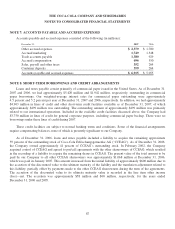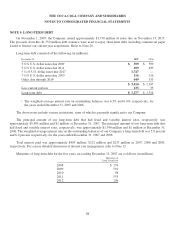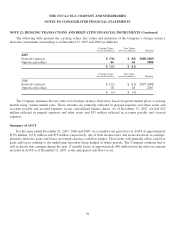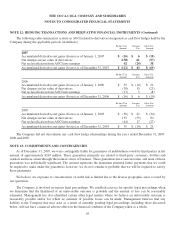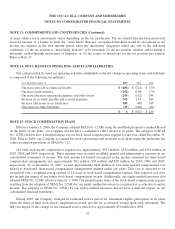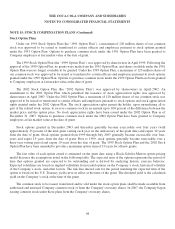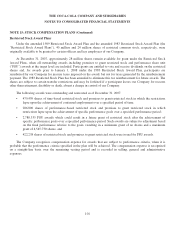Coca Cola 2007 Annual Report Download - page 99
Download and view the complete annual report
Please find page 99 of the 2007 Coca Cola annual report below. You can navigate through the pages in the report by either clicking on the pages listed below, or by using the keyword search tool below to find specific information within the annual report.
THE COCA-COLA COMPANY AND SUBSIDIARIES
NOTES TO CONSOLIDATED FINANCIAL STATEMENTS
NOTE 13: COMMITMENTS AND CONTINGENCIES (Continued)
of years subject to tax assessments varies depending on the tax jurisdiction. The tax benefit that has been previously
reserved because of a failure to meet the “more likely than not” recognition threshold would be recognized in our
income tax expense in the first interim period when the uncertainty disappears under any one of the following
conditions: (1) the tax position is “more likely than not” to be sustained, (2) the tax position, amount, and/or timing is
ultimately settled through negotiation or litigation, or (3) the statute of limitations for the tax position has expired.
Refer to Note 17.
NOTE 14: NET CHANGE IN OPERATING ASSETS AND LIABILITIES
Net cash provided by (used in) operating activities attributable to the net change in operating assets and liabilities
is composed of the following (in millions):
Year Ended December 31, 2007 2006 2005
(Increase) in trade accounts receivable $ (406) $ (214) $ (79)
(Increase) in inventories (258) (150) (79)
(Increase) decrease in prepaid expenses and other assets (244) (152) 244
Increase in accounts payable and accrued expenses 762 173 280
Increase (decrease) in accrued taxes 185 (68) 145
(Decrease) in other liabilities (33) (204) (81)
$6$ (615) $ 430
NOTE 15: STOCK COMPENSATION PLANS
Effective January 1, 2006, the Company adopted SFAS No. 123(R) using the modified prospective method. Based
on the terms of our plans, our Company did not have a cumulative effect related to its plans. The adoption of SFAS
No. 123(R) did not have a material impact on our stock-based compensation expense for the year ended December 31,
2006. Prior to 2006, our Company accounted for stock option plans and restricted stock plans under the preferable fair
value recognition provisions of SFAS No. 123.
Our total stock-based compensation expense was approximately $313 million, $324 million and $324 million in
2007, 2006 and 2005, respectively. These amounts were recorded in selling, general and administrative expenses in our
consolidated statements of income. The total income tax benefit recognized in the income statement for share-based
compensation arrangements was approximately $91 million, $93 million and $90 million for 2007, 2006 and 2005,
respectively. As of December 31, 2007, we had approximately $441 million of total unrecognized compensation cost
related to nonvested share-based compensation arrangements granted under our plans. This cost is expected to be
recognized over a weighted-average period of 1.8 years as stock-based compensation expense. This expected cost does
not include the impact of any future stock-based compensation awards. Additionally, our equity method investees also
adopted SFAS No. 123(R) effective January 1, 2006. Our proportionate share of the stock-based compensation expense
resulting from the adoption of SFAS No. 123(R) by our equity method investees is recognized as a reduction to equity
income. The adoption of SFAS No. 123(R) by our equity method investees did not have a material impact on our
consolidated financial statements.
During 2005, the Company changed its estimated service period for retirement-eligible participants in its plans
when the terms of their stock-based compensation awards provide for accelerated vesting upon early retirement. The
full-year impact of this change in our estimated service period was approximately $50 million for 2005.
97


